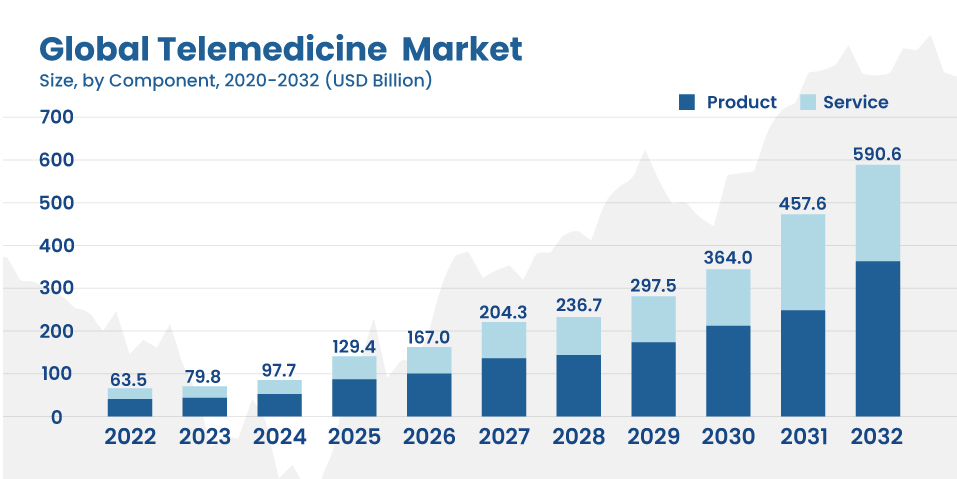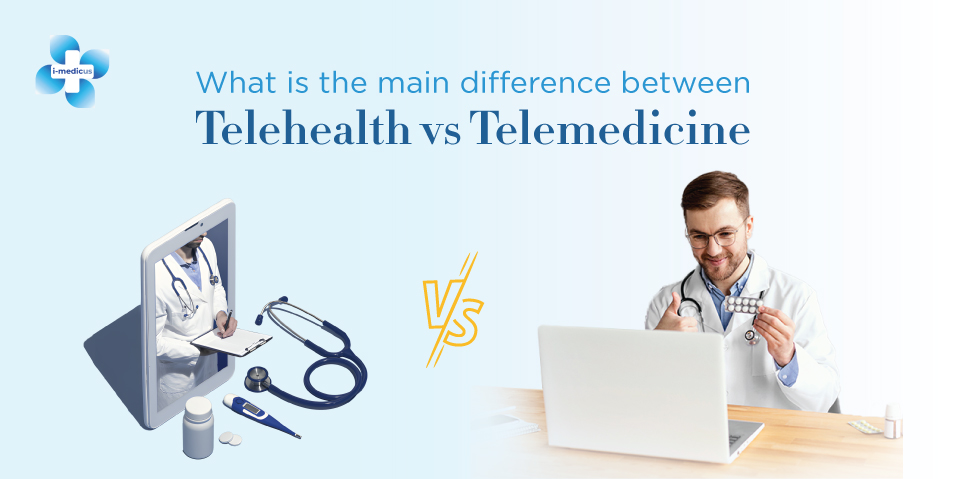Technology has revolutionized various industries. However, one sector where tech adoption was a concept has now turned real is healthcare. After COVID, the healthcare sector openly accepted technology and delivered medical services remotely. This is now recognized as telehealth vs telemedicine.
Now, telehealth and telemedicine are becoming preferred options for patients to conveniently get medical services at home. However, many people are confused between telehealth and telemedicine and wonder what the difference is between them. Well, telehealth is a general term, and telemedicine is a subset of telehealth.
So, if you want to know the difference between telehealth vs telemedicine. Then keep reading this article.
Here, we will learn about telehealth vs telemedicine. We will also cover their key differences. so that you can use the right term when considering remote medical services.
What Is Telehealth?
Telehealth is a broad term. Which refers to using technology to deliver telehealth services. when both patients and doctors use a platform for accessing or delivering medical services remotely: services such as providing education and training to healthcare workers, and managing healthcare data. This type of platform is referred to as a telehealth platform.
Telehealth Examples
- When a patient uses a telehealth app to check their body’s blood pressure or cholesterol level
- Providing health education, resources, and updates to the public
- When Patients use the platform to view their reports, book appointments, and order prescribed drugs
- When patients get online reminders about medicines and medical checkups
What Is Telemedicine?
Telemedicine is a subset of telehealth. It refers to delivering only clinical services to patients remotely, from online video consultations, prescriptions, and medicine reminders to tracking patients’ progress. When patients are using a platform to access these clinical services remotely, then it refers to a telemedicine platform.
Telemedicine Examples
- When a patient does a video consultation with a doctor
- When patients access their progress reports and medicine prescriptions remotely
- When doctors access patients’ sensitive information remotely
- When patients receive notifications and follow-up reminders for medicines and checkups
Some Recent Stats about Telehealth and Telemedicine

- The global telemedicine market size is expected to reach $590.9 billion by 2032 with a CAGR of 25.7%.
- Around 88% of Americans prefer to use telemedicine after COVID-19.
- 55% of people find they receive better care via online consultation.
- During the pandemic’s peak, more than 97% of healthcare experts were utilizing the telemedicine platform for patient care.
Difference Between Telehealth vs Telemedicine
| Telehealth | Telemedicine |
| It covers all types of healthcare services provided remotely | It is a part of telehealth that focuses only on remote medical services |
| It is more than the professional-patient conversation | It’s restricted only to the professional-patient conversation |
| It includes services provided by HCWs, professionals, educators, pharmacists, and frontline workers | Only healthcare professionals play a vital role |
| Telehealth includes a wide range of services, including reports, education, training, collaboration, etc | It is limited to providing only medical services remotely |
| It provides tracking and communication services to let patients deal with diseases | It only extends the coverage of professional reach |
Top 5 Benefits of Telehealth
Here are some key benefits of telehealth platforms:
1. Online Video Consultation
One of the biggest benefits of a telehealth platform is online video consultation. This has completely changed the healthcare industry. It allows doctors and patients to connect virtually over smartphones or computers to discuss. It completely eliminates the need for physical visits. And allows patients to get expert consultations from their homes. Plus, it also helps healthcare professionals to cater to more patients by saving time and reaching more patients digitally. So, patients and doctors both have increased access to telehealth.
2. Cost and Time Saving
Another benefit that both patients and healthcare professionals get is cost- and time-saving. After the telehealth platforms, patients don’t need to spend money to travel and wait in long queues for consultations. Now, patients have the most convenient option to schedule an appointment from home at a time convenient for them. Plus, healthcare professionals like Virtual Dermatologists also get numerous benefits because now professionals can reach out to more patients in their saved time and increase their income. So, it’s a win-win situation for both after telehealth.
3. More Accessible for Rural Areas
The biggest positive impact of telehealth seems to be in rural areas. Because previously, there were no healthcare facilities available in rural areas, especially access to specialists. With telehealth, patients can reach out to healthcare professionals, including specialists without worrying about the distance, because now rural areas also have internet connectivity and smartphones to use and get the best healthcare service. That overall leads to a promising future for telehealth.
4. Remote Patient Monitoring
Healthcare is an industry where documentation is one of the biggest headaches. Because there are so many documents stored, accessing the documents is a complex task itself. Telehealth solves this big issue by shifting all the documents and paperwork to digital storage. Now, all the details about the patients, including health progress, reports, weight, and other sensitive information, are stored in the cloud to be easily but securely accessible for patients and professionals only. So, doctors can easily access the data without worrying about too much paperwork and track their patient’s progress.
5. Enhanced Patient Engagement
Patient engagement has improved a lot with telehealth solutions. Now, patients stop worrying about travelling and waiting in long queues and can comfortably discuss their diseases with doctors and get the best possible care from home. Plus, these healthcare platforms can now keep the patients engaged by reminding medications, checkups, personalized routines, and healthy tips pertinent to the disease.
Top 5 Benefits of Telemedicine
Here are some key benefits of telemedicine platforms:
1. Quick Access to Specialist Care
Telemedicine is mainly focused on patient care. And one of the biggest advantages of telemedicine we’ve seen is quick access to specialists. This was not easy to get previously but now, with the help of telemedicine, patients can book appointments with specialized doctor without worrying about local availability or going too far for an in-person consultation. Patients have access to virtually connect with specialists and get the best care possible at home.
2. Enhanced Efficiency for Healthcare Providers
Another big impact to see after telemedicine is improved efficiency. Now, healthcare professionals are working more efficiently because they can treat patients virtually and save more time to cater to more patients, reduce the chances of cancellation, and have better control over the schedule. Plus, virtual consultation also makes the entire process hassle-free, which allows the doctor and patient to sit, relax, and have the best possible conversation to understand and provide the best care to the patient.
3. Reduced Risk of Infections
A common problem that doctors face with in person visits is the chance of spreading infection. However, telemedicine is a one stop solution for professionals. Because now there is no need for in-person meetings with patients. Now, doctors can virtually consult with the patients. Which reduces the risk of spreading infection. Plus, it is also helpful for patients to avoid going anywhere and get the treatment at their home to ensure a safer environment.
4. Support for Patients with Chronic Diseases
Telemedicine is the best option to deal with chronic diseases. Patients can get the best possible advice over video consultation and this will help to improve chronic conditions, especially during an emergency. Plus, there will be ongoing connections over the telemedicine platform.
5. Personalized Patient Care
Telemedicine improves patient care and provides more personalized treatment to patients by utilizing technology to get real-time insights and make better decisions. Plus, advanced technology helps to keep track of the progress of patients, providing feedback for adjustment and improvement and ensuring that patients take care of their medications on time with smart reminders. This overall approach helps to make the entire treatment more personalized for the patient and increases chances for faster recovery.
Looking for a Telemedicine app to grow your reach?
i-medicus is a one-stop telehealth partner
Final Words
Overall, telehealth and telemedicine are not the same, and there are some key differences between them. Where telehealth is ensured to make healthcare services more accessible remotely, telemedicine is mainly focused on delivering clinical services remotely. Both play a crucial role to make a huge impact on the healthcare sector. We hope this article helps you know everything about telehealth and telemedicine and the key differences between them.
FAQs
Q1. What is an example of telehealth vs telemedicine?
Telehealth includes all health-related services, including education, administrative tasks, remote patient morning, clinical care, etc. However, telemedicine is especially known for clinical care. Which includes video consultation, e-prescriptions, and remote patient monitoring.
Q2. What are the important differences between telehealth and in-person?
Telehealth makes consultations more easily accessible and comfortable than in-person meetings because telehealth allows patients to book their online consultations at their convenience.
Q3. What types of conditions can be treated with telemedicine?
Telemedicine can be treated especially for clinical care. Which includes infections, skin issues, mental health and chronic diseases like diabetes and hypertension.



